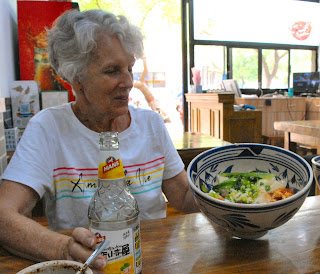A delightful day. We were met in the hotel lobby by Daniel, our ambassador for the day. We think he was rather pleased to have a tour group of two, as the previous day he had had 55!
We were in control, but he made suggestions along the way. Our first port of call was the Xi'an City Wall. Because our hotel is just off East Road, we walked and chatted all the way down to the East (Changle, "Eternal Joy") Gate, not that far, and then Daniel took us up on top of the wall. It is HUGE, with a full circuit being 13.7km — way too much to walk around!
We settled for walking from the East Gate to the southeast corner and back. Xi'an City Wall was erected during the 14th century Ming Dynasty period, under the regime of Emperor Zhu Yuanzhang. It successfully repelled all comers until the Mongols developed the strategy of attacking the wall armed with sandbags, dropping them at the foot of the wall and retiring. After a number of sallies, they had built up a ramp at the front of the wall, and the horsemen simply rode up and over the wall!
Different animals adorn the flagpoles on each wall of Xi'an. Here we have the dragon and the phoenix.
Anyway, after some time atop the wall, we came down and walked along to a bus stop on the East Road, where the route would take us in to the Bell Tower in the centre of the city. There is a Bell Tower and a Drum Tower. The bell was rung in the morning to tell the workers the city gates were open, and to go out of the city to work. The drum was sounded in the evenings to call them back before the gates were locked against all comers. We didn't go up the towers — there's apparently little to see up there. The best view is of the towers themselves, from below. The Bell Tower, built in 1384, is at the exact centre of the walled city. Its roofs are covered with dark green glazed tiles, and the apex is wrapped in genuine gold. When development in the city meant the city's centre moved about 1000 metres, the entire tower was moved to its current location in 1582 — quite an achievement!
Just behind the Drum Tower is Moslem Street, one of the most iconic parts of Xi'an. The Muslim quarter dates back to the Tang Dynasty (7th to 10th centuries), when the Muslim traders followed the Silk Road to Xi'an. They stayed, built their Great Mosque, and became an integral part of Xi'an. They are still here, a colourful part of the whole tapestry. Moslem Street is a busy market, mainly selling foods. The surrounding streets sell anything that can be sold! Suzie bought a couple of small souvenirs for the kids.
We went to the Great Mosque, which is an oasis of calm in the midst of a teeming city!
From here, we went across to the Post Office opposite. We wanted to post something back for Jonno that we hadn't intended to bring with us in the first place, and which he might need. This was an experience in itself. If you think there's a rigmarole involved in shipping something out of Australia, that's nothing compared with shipping out of China! But the staff were very helpful, and we got the whole job done in about 45 minutes. Ashwyn's gift went with the parcel, but Lilly's apparently contains some metal, so she will have to wait for it till we get home!
Now it was time for lunch. Daniel wanted to take us to a little restaurant that served a Xi'an staple — biáng biáng miàn, a wide hand-pulled noodle served with various combinations of other ingredients. I tell you, it's not that easy getting these bulky, slippery noodles to your mouth with a set of chopsticks. But we managed, and the meal was fully worth it. By the way, the traditional character for 'biáng' is apparently the most complicated character in the Chinese language!
biáng biáng miàn — the Traditional character for biáng is combined with the Simplified character for miàn
Then we went walking southward, towards the South Wall, going to Calligraphy Street (Shu Yuang Meen Street). On the way, we passed an old Taoist temple, the Wolong Temple, on Baishulin Street. According to the stele in the temple, it was built during Lingdi's reign (AD 168-189), Han Dynasty, more than 1,800 years ago.
From here, we continued to Calligraphy Street, where brushes, paper, calligraphic scrolls, and anything related to the venerable art of calligraphy can be found.
As it was after 3pm, we called it a day and returned to our hotel for a rest and a meal, a recharging of batteries, before we went out to the Giant Wild Goose Pagoda (Dàyàn ta) to wander the square for its amazing ambience and show of lights. We were also going to watch the Music Fountain show but our timing was bad, and we just caught the end of it. For an idea of what we missed, have a look at this YouTube clip!
So, off back home to bed, after a really delightful day.






















No comments:
Post a Comment